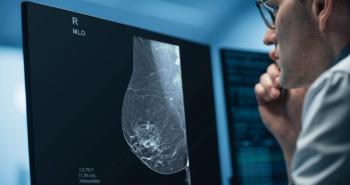
Digital Breast Tomosynthesis Cuts Recall Rates
Digital tomosynthesis results in fewer false positives and reduces recall rates, but has higher radiation doses than mammography.
Digital tomosynthesis for breast cancer screening has fewer false positives and reduces recall rates, particularly among young women, according to a study published in the journal
Tomosynthesis provides for three-dimensional reconstruction of breast tissue, allowing radiologists to view sequential slices. This is advantageous for women who have dense breast tissue. However, the radiation from tomosynthesis is approximately twice that of digital mammography.
Researchers from Yale University School of Medicine in New Haven, Conn., undertook a study to compare screening recall rates and cancer detection rates among 13,158 women who underwent conventional digital mammography, 6,100 of whom also underwent tomosynthesis.
The researchers found that the cancer detection rate among the women who underwent tomosynthesis was 5.7 per 1,000, compared with 5.2 per 1,000 who only underwent mammography. There was also a 30 percent reduction in the overall recall rate: 12 percent for mammography and 8.4 percent for tomosynthesis.
Recalls can cause significant anxiety among patients and adds to healthcare costs when they are not necessary. And the higher radiation dosage issue may be addressed with a new technology approved by the FDA that could reduce the dose.
“This technology involves taking the tomosynthesis data and collapsing it into planar imaging that resembles 2-D mammography,” co-author Brian M. Haas, MD, said in a release. “It has the potential to eliminate the need for acquisition of the conventional 2-D images in addition to the tomosynthesis images.”
Research is continuing as the team compares the cancers found on tomosynthesis are compared to those found on mammography, as well as tracking the women to ensure that the reduced recall rate did not result in missed cancers.
Newsletter
Stay at the forefront of radiology with the Diagnostic Imaging newsletter, delivering the latest news, clinical insights, and imaging advancements for today’s radiologists.




























